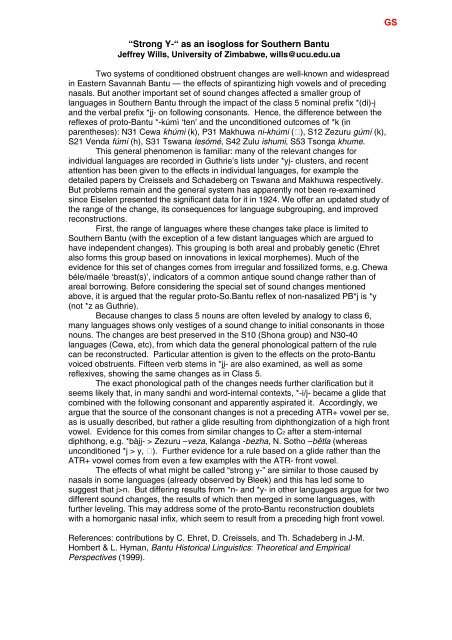here - 5th International Conference on Bantu Languages
here - 5th International Conference on Bantu Languages
here - 5th International Conference on Bantu Languages
Create successful ePaper yourself
Turn your PDF publications into a flip-book with our unique Google optimized e-Paper software.
“Str<strong>on</strong>g Y-“ as an isogloss for Southern <strong>Bantu</strong><br />
Jeffrey Wills, University of Zimbabwe, wills@ucu.edu.ua<br />
Two systems of c<strong>on</strong>diti<strong>on</strong>ed obstruent changes are well-known and widespread<br />
in Eastern Savannah <strong>Bantu</strong> — the effects of spirantizing high vowels and of preceding<br />
nasals. But another important set of sound changes affected a smaller group of<br />
languages in Southern <strong>Bantu</strong> through the impact of the class 5 nominal prefix *(di)-į<br />
and the verbal prefix *jį- <strong>on</strong> following c<strong>on</strong>s<strong>on</strong>ants. Hence, the difference between the<br />
reflexes of proto-<strong>Bantu</strong> *-kúmì ‘ten’ and the unc<strong>on</strong>diti<strong>on</strong>ed outcomes of *k (in<br />
parentheses): N31 Cewa khúmi (k), P31 Makhuwa ni-khúmi ( ), S12 Zezuru gúmí (k),<br />
S21 Venda fúmí (h), S31 Tswana lesómé, S42 Zulu ishumi, S53 Ts<strong>on</strong>ga khume.<br />
This general phenomen<strong>on</strong> is familiar: many of the relevant changes for<br />
individual languages are recorded in Guthrie’s lists under *yį- clusters, and recent<br />
attenti<strong>on</strong> has been given to the effects in individual languages, for example the<br />
detailed papers by Creissels and Schadeberg <strong>on</strong> Tswana and Makhuwa respectively.<br />
But problems remain and the general system has apparently not been re-examined<br />
since Eiselen presented the significant data for it in 1924. We offer an updated study of<br />
the range of the change, its c<strong>on</strong>sequences for language subgrouping, and improved<br />
rec<strong>on</strong>structi<strong>on</strong>s.<br />
First, the range of languages w<str<strong>on</strong>g>here</str<strong>on</strong>g> these changes take place is limited to<br />
Southern <strong>Bantu</strong> (with the excepti<strong>on</strong> of a few distant languages which are argued to<br />
have independent changes). This grouping is both areal and probably genetic (Ehret<br />
also forms this group based <strong>on</strong> innovati<strong>on</strong>s in lexical morphemes). Much of the<br />
evidence for this set of changes comes from irregular and fossilized forms, e.g. Chewa<br />
béle/maéle ‘breast(s)’, indicators of a comm<strong>on</strong> antique sound change rather than of<br />
areal borrowing. Before c<strong>on</strong>sidering the special set of sound changes menti<strong>on</strong>ed<br />
above, it is argued that the regular proto-So.<strong>Bantu</strong> reflex of n<strong>on</strong>-nasalized PB*j is *y<br />
(not *z as Guthrie).<br />
Because changes to class 5 nouns are often leveled by analogy to class 6,<br />
many languages shows <strong>on</strong>ly vestiges of a sound change to initial c<strong>on</strong>s<strong>on</strong>ants in those<br />
nouns. The changes are best preserved in the S10 (Sh<strong>on</strong>a group) and N30-40<br />
languages (Cewa, etc), from which data the general ph<strong>on</strong>ological pattern of the rule<br />
can be rec<strong>on</strong>structed. Particular attenti<strong>on</strong> is given to the effects <strong>on</strong> the proto-<strong>Bantu</strong><br />
voiced obstruents. Fifteen verb stems in *jį- are also examined, as well as some<br />
reflexives, showing the same changes as in Class 5.<br />
The exact ph<strong>on</strong>ological path of the changes needs further clarificati<strong>on</strong> but it<br />
seems likely that, in many sandhi and word-internal c<strong>on</strong>texts, *-i/į- became a glide that<br />
combined with the following c<strong>on</strong>s<strong>on</strong>ant and apparently aspirated it. Accordingly, we<br />
argue that the source of the c<strong>on</strong>s<strong>on</strong>ant changes is not a preceding ATR+ vowel per se,<br />
as is usually described, but rather a glide resulting from diphth<strong>on</strong>gizati<strong>on</strong> of a high fr<strong>on</strong>t<br />
vowel. Evidence for this comes from similar changes to C2 after a stem-internal<br />
diphth<strong>on</strong>g, e.g. *bàįj- > Zezuru –veza, Kalanga -bezha, N. Sotho –bêtla (w<str<strong>on</strong>g>here</str<strong>on</strong>g>as<br />
unc<strong>on</strong>diti<strong>on</strong>ed *j > y, ). Further evidence for a rule based <strong>on</strong> a glide rather than the<br />
ATR+ vowel comes from even a few examples with the ATR- fr<strong>on</strong>t vowel.<br />
The effects of what might be called “str<strong>on</strong>g y-” are similar to those caused by<br />
nasals in some languages (already observed by Bleek) and this has led some to<br />
suggest that į>n. But differing results from *n- and *y- in other languages argue for two<br />
different sound changes, the results of which then merged in some languages, with<br />
further leveling. This may address some of the proto-<strong>Bantu</strong> rec<strong>on</strong>structi<strong>on</strong> doublets<br />
with a homorganic nasal infix, which seem to result from a preceding high fr<strong>on</strong>t vowel.<br />
References: c<strong>on</strong>tributi<strong>on</strong>s by C. Ehret, D. Creissels, and Th. Schadeberg in J-M.<br />
Hombert & L. Hyman, <strong>Bantu</strong> Historical Linguistics: Theoretical and Empirical<br />
Perspectives (1999).<br />
GS


